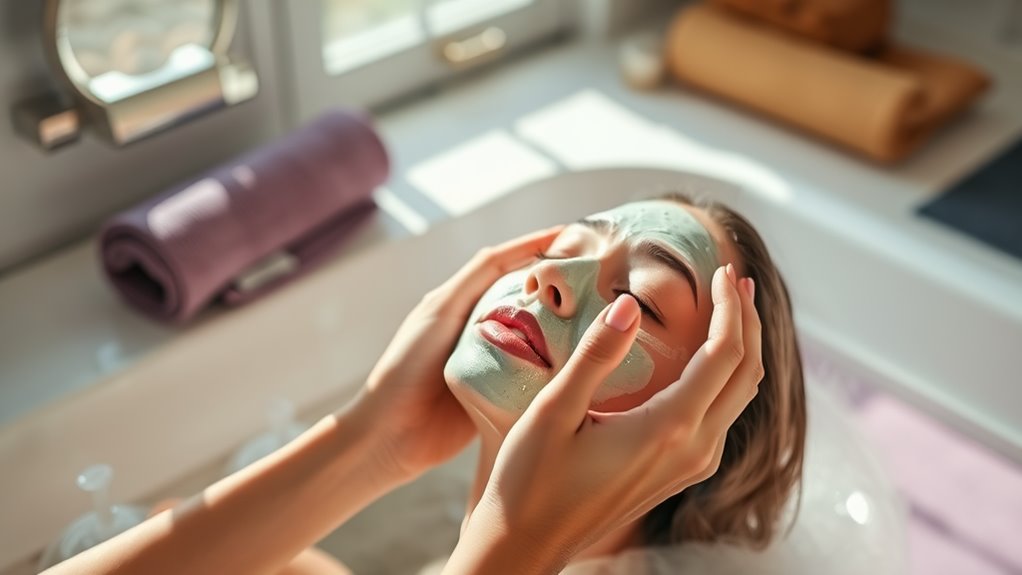Simple Changes to Boost Your Stress & Skin- How to Cope Routine
You can boost your stress and skin health with these simple tweaks. Start by identifying your stress triggers through daily journaling to spot patterns. Practice mindfulness techniques like the 4-7-8 breathing method to lower cortisol and calm inflammation. Choose nutrient-rich foods, such as berries for antioxidants and omega-3s for skin repair. Add relaxing exercises like yoga, develop a basic skincare routine, and prioritize good sleep habits while tracking progress. Explore these strategies further for even better outcomes.
Key Takeaways
- Practice deep breathing exercises daily to reduce stress and inflammation in the skin.
- Incorporate nutrient-rich foods, like berries and omega-3 sources, to support skin health and lower inflammation.
- Follow a simple skincare routine with a gentle cleanser, moisturizer, and SPF to maintain skin balance.
- Establish consistent sleep habits, such as a regular bedtime, to regulate stress hormones and improve skin recovery.
- Track stress and skin changes in a daily journal to identify patterns and make effective adjustments.
Identify Stress Triggers
Have you ever wondered what sets off your stress, making it harder to maintain a clear complexion?
Stress and skin: how to cope begins with pinpointing those triggers, as they activate the body’s stress response, releasing cortisol that inflames pores and disrupts oil production.
You heighten your awareness by tracking patterns in a daily journal—note situations like work deadlines or arguments that spike your anxiety.
Actively observe physical signs, such as tension headaches or breakouts, to link them back to specific events.
This scientific approach empowers you to differentiate between acute stressors, like a bad day, and chronic ones, like ongoing financial worries.
By identifying these culprits precisely, you’re laying the groundwork for clearer skin without unnecessary overwhelm. Incorporating effective skincare routines can help mitigate the effects of stress on your skin, based on personal experiments that show positive outcomes.
Embracing a holistic approach can further integrate these insights into your daily routine for sustained stress relief and skin improvement.
Practice Daily Mindfulness Techniques
Once you’ve identified your stress triggers, incorporating daily mindfulness techniques offers a practical way to reduce cortisol levels and promote clearer skin.
You start with simple practices like deep breathing exercises, which activate your parasympathetic nervous system to lower stress hormones. For instance, try the 4-7-8 method: inhale for four seconds, hold for seven, and exhale for eight, repeating several times daily.
Meditation apps make it easy; you spend just 10 minutes focusing on your breath to enhance emotional regulation.
Yoga combines movement and mindfulness, helping you release tension while improving blood flow to your skin.
Track your progress by journaling how these routines affect your stress and complexion. Consistency builds resilience, as studies show regular mindfulness decreases inflammation, leading to healthier skin over time.
Incorporating these practices into your routine can also enhance overall well-being, supporting a balanced lifestyle.
Choose Nutrient-Rich Foods for Skin Health
Choosing nutrient-rich foods plays a key role in enhancing your skin’s health and resilience. These foods deliver essential vitamins and minerals that combat oxidative stress and inflammation, common culprits in skin aging and damage.
For instance, incorporate vitamin C-rich options like citrus fruits and bell peppers; they boost collagen production and protect against UV damage.
Don’t overlook omega-3 fatty acids from fatty fish or walnuts, as they reduce inflammation and maintain your skin’s barrier.
Antioxidants in berries and leafy greens neutralize free radicals, promoting a clearer complexion. Moreover, these nutrient-packed choices can also enhance strong hair by supporting overall nutrient absorption and hair follicle health.
Hydrate with water-rich vegetables such as cucumbers and tomatoes to keep your skin plump and detoxified.
Make smart swaps, like opting for whole grains over refined ones, to ensure you’re fueling your body efficiently.
Track your intake to notice improvements in texture and glow, making this a sustainable habit for long-term benefits.
Additionally, to support clearer skin, consider avoiding high-sugar foods that may contribute to acne flare-ups.
Incorporate Relaxing Exercises
Incorporating relaxing exercises into your daily routine not only eases stress but also supports skin health by lowering cortisol levels, which can otherwise trigger inflammation and breakouts. You’ll benefit from activities like yoga, which promotes mindfulness and reduces tension, or deep breathing techniques that calm your nervous system. These exercises enhance blood flow, aiding skin repair without added strain. Start with short sessions—aim for 10-15 minutes daily—to see improvements in both mood and complexion. Additionally, engaging in these practices can help counteract the effects of stress-induced inflammation on your skin, as it plays a key role in exacerbating various dermatological issues. Moreover, combining these exercises with natural remedies can offer quick relief for irritated skin, enhancing overall skin soothing effects.
To guide you, here’s a practical breakdown:
| Exercise | Benefits |
|---|---|
| Yoga | Lowers cortisol, improves flexibility |
| Deep Breathing | Reduces anxiety, enhances oxygenation |
| Tai Chi | Balances energy, minimizes inflammation |
| Walking in Nature | Boosts endorphins, eases mental load |
| Progressive Muscle Relaxation | Relieves physical tension, aids recovery |
Develop a Simple Skincare Regimen
You can start by choosing essential products tailored to your skin type, such as a gentle cleanser and moisturizer, to build a straightforward regimen.
Next, follow daily steps like cleansing in the morning and evening to keep your skin balanced and protected.
This practical method ensures you’re supporting your skin’s health while integrating it into your stress management routine.
Additionally, recognizing the key characteristics of your skin type can further refine your product choices for optimal results.
To make this regimen even more effective, first determine your skin type using a straightforward process.
Choose Essential Products
A solid skincare regimen hinges on selecting a few essential products that target your skin’s needs, such as a gentle cleanser, moisturizer, and sunscreen, to maintain a balanced routine without overwhelming complexity.
To choose wisely, focus on these key steps:
-
Identify your skin type: Determine if it’s oily, dry, combination, or sensitive using simple tests, like observing how your skin feels after washing, to guide product selection and prevent irritation.
-
Prioritize active ingredients*: Select products with proven components like *hyaluronic acid for hydration or niacinamide for brightening, based on scientific evidence, to address specific issues effectively.
-
Check for simplicity and compatibility: Opt for multi-tasking items that combine functions, ensuring they’re free from harsh chemicals, so they integrate seamlessly into your daily life.
-
Consider sustainability and cost: Choose eco-friendly, budget-friendly options with minimal packaging, as studies show these reduce environmental impact while maintaining efficacy for long-term use.
Follow Daily Steps
Once you’ve chosen your essential products, building a simple skincare regimen involves consistent daily steps that keep your skin healthy and balanced.
For mornings, start with a gentle cleanser to remove impurities and maintain the skin’s pH; apply a serum with antioxidants like vitamin C to neutralize free radicals from environmental stressors. Follow with a lightweight, non-comedogenic moisturizer to lock in hydration, and always add broad-spectrum SPF 30+ to protect against UV-induced damage, which exacerbates stress-related aging.
In evenings, double-cleanse: use an oil-based cleanser for makeup and sunscreen residue, then a foaming one to clear pollutants. Apply targeted treatments—such as hyaluronic acid for dryness or niacinamide for inflammation—before sealing with a richer moisturizer.
This routine stabilizes your skin barrier, reduces cortisol’s impact on breakouts, and fosters long-term resilience. Monitor changes weekly for adjustments, ensuring efficacy without overload.
Establish Healthy Sleep Habits
Establishing healthy sleep habits is essential for reducing stress and improving skin health, as poor sleep disrupts hormonal balance and accelerates aging. Additionally, during the colder months, pairing these habits with winter skincare strategies can help prevent dryness and maintain a protective barrier.
You’ll notice that quality rest helps regulate cortisol levels, which in turn minimizes breakouts and inflammation. By adopting simple, evidence-based routines, you can enhance your body’s natural repair processes during sleep.
-
Maintain a consistent schedule****: Go to bed and wake up at the same time daily to stabilize your circadian rhythm, reducing stress hormones.
-
Create a wind-down routine****: Engage in relaxing activities like reading or deep breathing for 30 minutes before bed to promote melatonin production.
-
Optimize your sleep environment****: Keep your room cool (around 65°F), dark, and free of noise to improve sleep depth and skin regeneration.
-
Limit stimulants: Avoid caffeine after noon and heavy meals close to bedtime to prevent disruptions in REM sleep, supporting hormonal balance.
To further support radiant skin, it’s important to address morning skincare mistakes that could undermine your sleep efforts.
Track Your Progress and Adjustments
After building on your sleep habits, you’ll regularly monitor your progress to fine-tune your stress and skin routine. Start by keeping a daily journal, noting your stress levels, sleep quality, and skin changes using a simple scale or photos.
For accuracy, incorporate tools like apps that track heart rate variability or sleep cycles, providing data-driven insights. Analyze patterns weekly: if high stress correlates with breakouts, adjust by adding mindfulness exercises or tweaking your bedtime.
Actively set measurable goals, like reducing anxiety scores by 20%, and revisit them monthly. This scientific approach ensures evidence-based tweaks, such as modifying diet or routines, enhance resilience and skin health. To further support your skin health, make sure to avoid skincare mistakes that can negatively impact your overall routine.
Additionally, by addressing common mistakes in your skincare routine, you can further optimize your efforts for improved skin health and appearance.

